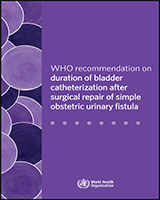Introduction
An obstetric fistula is an abnormal opening between a woman’s genital tract and her urinary tract and/or rectum caused by prolonged obstructed labour. Obstetric fistula has devastating consequences for the lives of women and their families.
The prevalence of obstetric fistula is approximately 1.6 per 1000 women of reproductive age in sub-Saharan Africa and 1.2 per 1000 in South Asia.
Most obstetric urinary (vesicovaginal) fistulae can be repaired surgically, and the routine postoperative care of these patients involves the use of an indwelling urinary catheter to promote continuous urine drainage and to allow tension-free healing of the surgical scar. The duration of routine postoperative bladder catheterization is not standardized and varies widely in clinical practice, ranging from 5 to 42 days, with direct health and budgetary implications.
Long duration of bladder catheterization to allow complete healing can be inconvenient for the woman, her family and care providers as it is associated with more discomfort and inconvenience to patients, increased risk of infection and erosion related to catheterization, more intensive nursing care and more cost per patient. Shorter periods of postoperative bladder catheterization have been tested and shown to be effective in allowing complete healing with improved patient comfort and potentially lower risks of catheter-related urinary tract infections.
Evidence-based guidance on the duration of bladder catheterization after surgery can improve the health and well-being of women with obstetric fistula. The goal of the present guideline is to consolidate guidance for the effective management of the indwelling catheter in women after the surgical repair of simple obstetric urinary fistula.
Target audience
The primary audience for this guideline is health-care professionals, particularly fistula surgeons and nurses providing postoperative care to women after surgery for obstetric urinary fistula. The guideline will also be useful to national and local policy-makers, and staff of nongovernmental and other organizations involved in fistula care services.
Guideline development methods
This guideline was developed following standardized operating procedures in accordance with the process described in the WHO handbook for guideline development. Briefly, this process included: (i) identification of the priority question and critical outcomes; (ii) retrieval of the evidence; (iii) assessment and synthesis of the evidence; (iv) formulation of the recommendation; and (v) planning for the dissemination, implementation, impact evaluation and updating of the guideline. The scientific evidence supporting the recommendation was evaluated using the Grading of Recommendations Assessment, Development and Evaluation (GRADE) approach. A systematic review was conducted, and this was used to prepare evidence profiles for the priority question. The World Health Organization (WHO) subsequently convened a Technical Consultation in May 2017 where an international group of experts – the Guideline Development Group (GDG) – formulated and approved the recommendation based on the synthesized evidence.
Recommendation
At the WHO Technical Consultation, the GDG adopted the following recommendation covering the priority question related to the duration of catheterization after surgical repair of simple obstetric urinary fistula:
For women in the postoperative period after the surgical repair of a simple obstetric urinary fistula, short duration bladder catheterization (7 to 10 days) is recommended as an alternative to longer duration of catheterization.
Remarks
The GDG acknowledges that there are several ways of defining the severity of fistula. For the purposes of this recommendation, the GDG considered “simple” fistula as a mid-anterior vaginal wall fistula with minimal scarring and with a diameter of 3 cm or less.
For fistula cases that are not considered simple, an option different to the one recommended in this guideline may be required.
The GDG acknowledges the variation in the use of bladder catheter after fistula surgery and notes that some surgeons may consider “short” duration of catheterization to be less than 7 days. However, for the purposes of this recommendation, the GDG defines short duration as 7 to 10 days.
This recommendation is applicable to any context where women experience simple obstetric urinary fistula due to obstructed labour.
The GDG accepts the uncertainty in the outcomes for shorter and longer duration of bladder catheterization in light of other benefits, such as improvement in patients’ comfort, potential reduction in the risk of infections associated with the catheterization, and decrease in patients’ needs for health services.
While shorter hospitalization associated with shorter postoperative bladder catheterization would increase the availability of fistula care services (so that more patients could potentially be treated), this should be carefully balanced with the quality of services (i.e. the provision of a holistic care package to women who are recovering from obstetric fistula repair).
For this recommendation, the overall quality of evidence was graded as low to moderate. In the formulation of the recommendation, the GDG also considered the balance between benefits and harms, the values and preferences of stakeholders, and the resource implications of the intervention. To ensure that the recommendation is correctly understood and applied in practice, the contributing experts formulated a set of remarks, as listed above, to accompany the recommendation, based on key points of discussion. Guideline users should refer to these remarks, as well as the evidence summary (presented in the full text of the guideline) if there is any doubt as to the basis for the recommendation or any question about how to best implement it.
In accordance with WHO guideline development procedures, this recommendation will be regularly reviewed and updated following identification of new evidence, with major reviews and updates at least every five years. WHO welcomes suggestions regarding additional questions for inclusion in future updates of the guideline.

